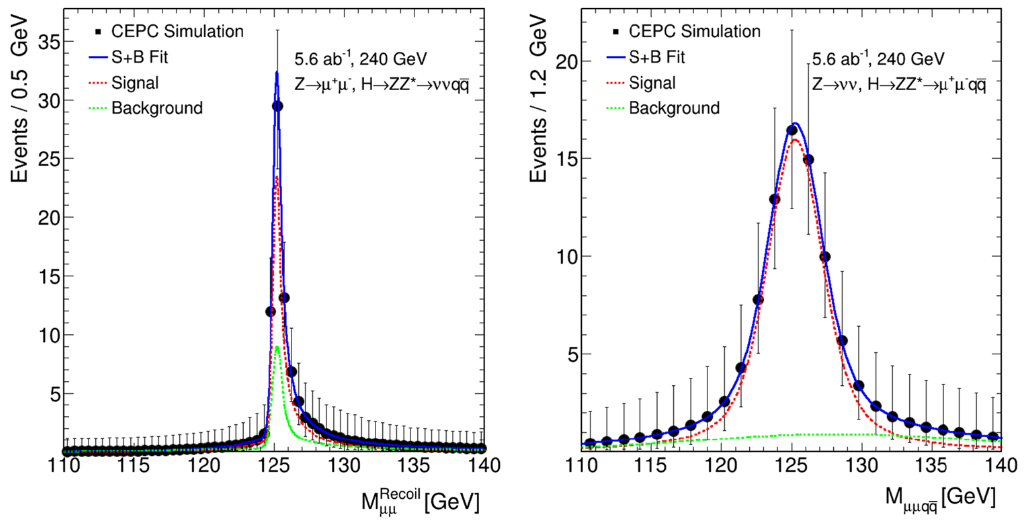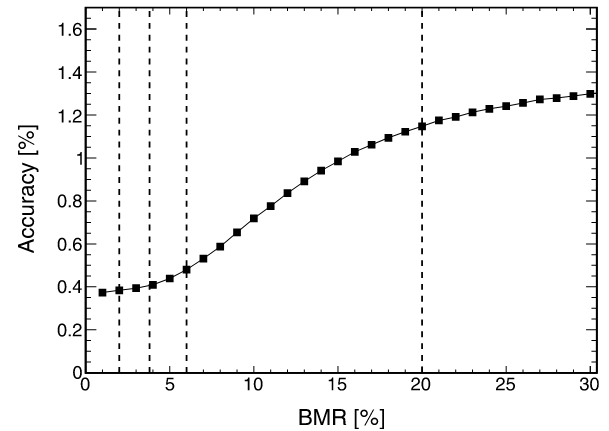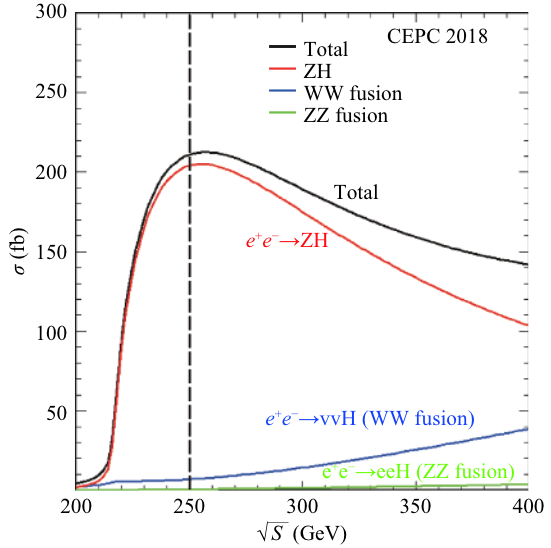Higgs Edit Page
Contents
- Physics potential for the H\(\rightarrow ZZ^{*}\) decay at the CEPC
- Search for invisible decays of the Higgs boson produced at the CEPC
- Precision Higgs physics at the CEPC
Physics potential for the H\(\rightarrow ZZ^{*}\) decay at the CEPC
The precision of the yield measurement of the Higgs boson decaying into a pair of \(Z\) bosons process at the Circular Electron Positron Collider (CEPC) is evaluated. Including the recoil \(Z\) boson associated with the Higgs production (Higgsstrahlung) a total of three \(Z\) bosons are involved for this channel, from which final states characterized by the presence of a pair of leptons, quarks, and neutrinos are chosen for the signal. Two analysis approaches are compared and the final statistical precision of \({\sigma}_{\mathrm{ZH}}{\cdot}\)BR(\(H \rightarrow ZZ^{*}\)) is estimated to be 6.9% using a multivariate analysis technique, based on boosted decision trees. The relative precision of the Higgs boson width, using this \(H \rightarrow ZZ^{*}\) decay topology, is estimated by combining the obtained result with the recision of the inclusive \(ZH\) cross section measurement.
Further reading: R. Kiuchi, et al., Physics potential for the \(H\rightarrow ZZ^*\) decay at the CEPC, Eur. Phys. J. C (2021) 81:879
Search for invisible decays of the Higgs boson produced at the CEPC
The Circular Electron Positron Collider (CEPC) proposed as a future Higgs boson factory will operate at a center-of-mass energy of 240 GeV and accumulate \(5.6 ab^{-1}\) of integrated luminosity in 7 years. In this paper, we estimate the upper limit of BR(\(H \rightarrow\) inv) for three independent channels including two leptonic channels and one hadronic channel at the CEPC. Based on the full simulation analysis, the upper limit of BR(\(H \rightarrow\) inv) could reach 0.26% at the 95% confidence level. In the Stand Model (SM), the Higgs boson can only decay invisibly via \(H\rightarrow ZZ^\ast\rightarrow\nu\overline{\nu}\nu\overline{\nu}\), so any evidence of invisible Higgs decays that exceeds BR(\(H \rightarrow\) inv) of SM will indicate a phenomenon that is beyond the SM (BSM). The invariant mass resolution of visible hadronic decay system \(ZH(Z \rightarrow qq\), \(H \rightarrow\) inv) is simulated and the physics requirement at the CEPC detector to reach this is given.
Further reading: Y. Tan, et al., Search for invisible decay of a Higgs boson produced at the CEPC, Chinese Physics C Vol. 44, No. 12 (2020) 123001
Precision Higgs physics at the CEPC
The discovery of the Higgs boson with its mass around 125 GeV by the ATLAS and CMS Collaborations marked the beginning of a new era in high energy physics. The Higgs boson will be the subject of extensive studies of the ongoing LHC program. At the same time, lepton collider based Higgs factories have been proposed as a possible next step beyond the LHC, with its main goal to precisely measure the properties of the Higgs boson and probe potential new physics associated with the Higgs boson. The Circular Electron Positron Collider (CEPC) is one of such proposed Higgs factories. The CEPC is an \(e^+e^−\) circular collider proposed by and to be hosted in China. Located in a tunnel of approximately 100 km in circumference, it will operate at a center-of-mass energy of 240 GeV as the Higgs factory. In this paper, we present the first estimates on the precision of the Higgs boson property measurements achievable at the CEPC and discuss implications of these measurements.
Further reading: F. An, et al., Precision Higgs Physics at the CEPC, Chinese Physics C Vol. 43, No.4 (2019) 043002


